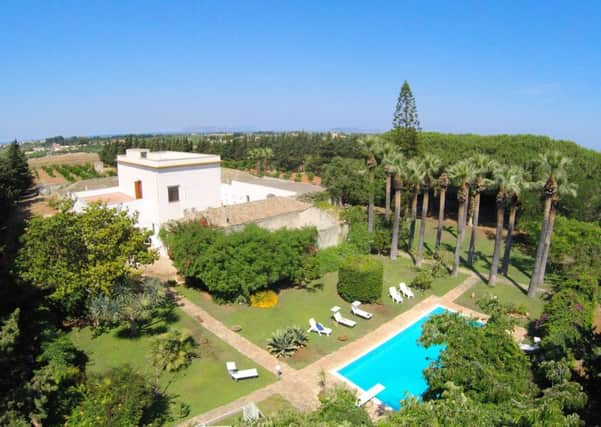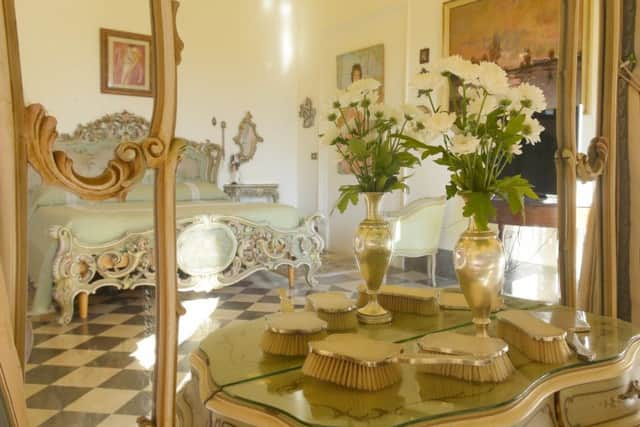Travel: A taste of Sicily's scents and serenity


Rainbows of wild flowers, birds swooping through the silence and the mint in the chef’s garden: moments of tingling sensation which will define Sicily for me.
The mint is to ward off the mosquitoes as the chef’s father showed us the produce used in Le Lumie, an up-and-coming restaurant in Marsala.
Advertisement
Hide AdChef Emanuele Russo is sharing his culinary passion by teaching us to cook a Sicilian meal and we are out in the kitchen garden looking at – and sampling – the raw ingredients.


First we attempt to make the local pasta – a fine corkscrew ribbon called busiate. It is the rolling technique, using a fine skewer, which seems to defeat us all.
Russo then chops and dices some of that doorstep-fresh aubergine, celery, onion and tomatoes for the caponata.
Next he grinds the pesto’s almonds and garlic before adding tomatoes, as local tradition demands.
We return to pasta, this time with the addition of cocoa powder and wrapped round stout bamboo before being fried, to make the shell for cannoli.


Stuffed with sweet ricotta, lemon and chocolate chips, cannoli must qualify as the taste of Sicily if the number of times we are introduced to it is anything to go by.
Advertisement
Hide AdOur handiwork leaves a little to be desired, but Russo magics it all into a feast worthy of his chic hillside restaurant.
The flavours come at us from all sides. In the markets of Palermo we snack on panino con pannelle (chickpea fritters in a roll), the table groans with antipasti at lunchtime and Sicilian specialities jostle for our attention as night falls.
Advertisement
Hide AdThe atmospheric Cantina Siciliana in Trapani, where traditional puppets gaze over the bottles of Sicilian wines, serves up a selection of Tranapese dishes.
In chef patron Pino Maggiore’s kitchen, the accent is on the sea – octopus, sardines, swordfish – although aubergines, tomatoes and other in-season veg are not forgotten.
A similar approach to seasonal and local produce is on show at Ciacco in the ancient heart of the city of Marsala.
Francesco Alagna quit a metropolitan life in Milan to concentrate on authentic Sicilian food and wine and passionately delivers its flavours from a tiny galley above the delicatessen-bar.
Marsala is obviously a place to explore – and not just its gourmet side: there are layers of history to peel back.
Much is made of Garibaldi landing there in May 1860 and thus igniting the flame of Italian unification, but the town’s layers go right back to the Phoenicians.
Advertisement
Hide AdSicily – or what we saw of the western part of the Italian island – is fertile, a cook’s paradise.
Based at a rustic villa, Baglio Maurasa, in the Marsala countryside, we have every reason to seek out the best of the area’s produce and prepare it ourselves.
Advertisement
Hide AdBut we are also drinking in the scenery where vines, olive groves, citrus fruits and fields of veg – or sometimes the panels of a solar farm – fill the horizon.
We pass both modern wind turbines and ancient windmills, with the most photogenic located beside the salt pans at the Stagnone Lagoon as we make our way out to the island of Mozia.
This tiny outcrop not far from our villa was an important centre of Phoenician life and death and its small museum has exquisite finds excavated from its funeral sites.
Beautifully decorated pottery bottles for embalming oil line up beside artefacts from the succeeding generations, discovered initially in the early 20th century by Joseph Whitaker, an Anglo-Sicilian whose family had made their money from wine and banking.
Most arresting is Giovinetto di Mozia, a 2,500-year-old Greek youth whose muscles seem to ripple beneath his robe, ignoring the fact he is made of Mozia’s marble and lay hidden until 1979.
Outside, the island is full of incredible plants – towering cacti, those swathes of wild flowers – and we stoop to release the scent from wild rosemary.
Advertisement
Hide AdHere, I should mention that our host is Scent of Sicily, the company which manages our villa and many more in the island, and this assault on our senses chimes beautifully for owner Renato Gagliano.
With Mozia a childhood haunt, Renato is the perfect guide as we circuit the island and the remnants of its ancient heyday.
Advertisement
Hide AdHeading back to the ferry we pass olive groves and vines of the grillo grape.
This is good preparation for the next stop of the day: the Florio winery where we see what the grillo makes – hundreds of thousands of litres of Marsala, the fortified wine made in the town of the same name.
It is from a very modern visitor centre that we start our tour, unprepared for the powerful aroma which will engulf us as we step into the warehouse where six million litres of spirit lies in barrels, maturing.
Like all good drinks, there is a British connection: it was created in 1773 by John Woodhouse who spotted the potential for another fortified wine alongside Madeira and port to tempt the English.
In the 1790s, Woodhouse started producing Marsala commercially, creating a successful business, purchased by Florio in the late 19th century.
Our walk and talk through the history and nuances of its production, is rewarded by a sensory wine tasting.
Advertisement
Hide AdLuckily our senses, heightened by all the exercise Sicily’s scents and flavours have already given them, are up for the challenge.
Our guide matches food with three Marsalas. Like Madeira, port and sherry, there are many more variations here than we find at home. None we taste resembles the sweet drink used for British tiramisu.
Advertisement
Hide AdAnother new sensation to take home with us. For now, it’s the sense of peace beside the pool, watching a lizard scurry from a geranium pot as the birds lazily swoop from bougainvillea to olive tree.
Much of the Marsala region is low lying, yet seemingly always on the horizon is a striking, steep, hill fading into the midday heat haze, streetlights picking out its peak at night. This, we are to discover, is Erice, a fortified town, 2,400 feet above Trapani. It’s up a well made road that snakes up the side of the cliff, with stunning vistas for passengers. Another time, however, I’d love to try the ten-minute cable car ride up from Trapani.
Whichever ascent, the reward is a village that enchants. Below the narrow streets glint in the sun, the intricate pattern of well-worn stones and cobbles creating a modern regularity at odds with its medieval roots.
Pastries are the temptation here. We sample a Genovesi from the Pasticceria Grammatico Maria to fuel our climb to find the best panorama to watch the sun set on another day of Sicilian sensations.
• Scent of Sicily has more than 70 villas across the island. For more details, see www.scent-of-sicily.com Baglio Maurasa sleeps up to ten and costs E3,200-E3,800 (E2,900-E3,400 for eight people) for a week in July and August. The Dome Penthouse in Marsala sleeps up to eight. It costs E2,500 to E3,500 (E2,200-E3,100 for six people) per week in July and August. EasyJet, Ryanair, British Airways and KLM are among the airlines which fly into Palermo and Ryanair flies into Trapani-Birgi.